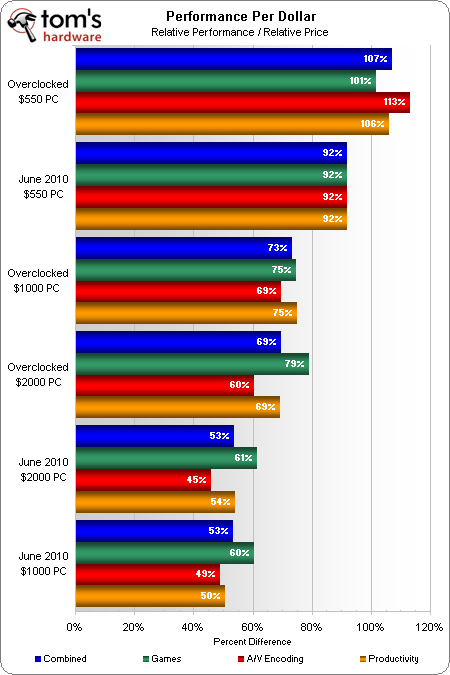System Builder Marathon, June 2010: System Value Compared
Value Conclusion
In the performance PC market, differences in price are usually larger than differences in performance. Exceptions to that observation usually occur outside the performance market with “low-energy” parts that cost more while providing less performance, and low-cost parts that perform so poorly they can’t be held to performance-market standards. The value sweet spot for our builds has often been around $700, so it’s going to be interesting to see how effective our budget reductions have been at knocking the cheapest PC off its bang-for-the-buck pedestal.
The chart below is based on a $500 target price for the cheapest PC even though its actual price was $545, because the other budgets are multiples of $500.
The cheapest PC wins with an overclocked value of 107%. While we expected the low price of the $550 machine’s AMD Athlon II processor to offer excellent value in our encoding and productivity suites, gaming value for the $2,000 machine’s pair of GeForce GTX 470 graphics took us by surprise. The incredible performance of this SLI configuration surpassed the machine's overall value by an impressive 10%.
While the chart above might provide numeric value analysis, empirical value will be different for every buyer. Only the $2,000 PC’s Core i7 processor, for example, was capable of rendering 3ds Max animations at less then 30 seconds per frame. Similarly, nothing less than the $1,000 system’s Radeon HD 5830 CrossFire configuration could be consistently relied upon to play high-quality games smoothly at 1080p. Individual requirements aside, the numerical winner is still Paul Henningsen’s overclocked $550 PC.
Get Tom's Hardware's best news and in-depth reviews, straight to your inbox.
-
manitoublack Another great SBM. Goodluck to US Punters who get the chance to win theses systems. Look forward to the next round where Graphics hardware will take a step out of the lime light.Reply -
touchdowntexas13 It's interesting to see the performance/dollar shoot up for the $2000 pc when it comes to games. That just goes to show you how much of the budget went into graphics muscle. These machines were definitely built with gaming in mind.Reply -
Crashman touchdowntexas13It's interesting to see the performance/dollar shoot up for the $2000 pc when it comes to games. That just goes to show you how much of the budget went into graphics muscle. These machines were definitely built with gaming in mind.Yes, the only way to smash those benchmarks is with a faster CPU (2/3 of tests) or graphics (1/3 of tests). The problem with upgrading the CPU is that the 980X would cost 50% of the total budget. We haven't seen a big improvement in overclocking by using a higher-model quad-core i7Reply -
touchdowntexas13 CrashmanYes, the only way to smash those benchmarks is with a faster CPU (2/3 of tests) or graphics (1/3 of tests). The problem with upgrading the CPU is that the 980X would cost 50% of the total budget. We haven't seen a big improvement in overclocking by using a higher-model quad-core i7Reply
Oh no I wasn't suggesting at all that you should have gone with a 980X for the $2000 build. That's way too expensive for a $2000 limit. The 930 does it's job just fine.
It just amazed me that two 470's in SLI were able to best the performance/dollar of the cheaper builds. Typically you see diminishing gains as you get into the more expensive components.
It was a very interesting set of articles any way you look at it. Gamers on a budget should especially be interested in this SBM. -
Crashman touchdowntexas13It just amazed me that two 470's in SLI were able to best the performance/dollar of the cheaper builds. Typically you see diminishing gains as you get into the more expensive components.I was pretty amazed too, but I really want to give credit to $1000 PC builder Don for making the GTX 470 SLI suggestion for the $2000 machine. Spot on Don!Reply
-
Tamz_msc Overall this month's SBM was good, especially the scalability of the 470s was brought into prominence.Though overclocking those in SLI is certainly not a viable option, unless one steals power from the Hoover Dam.Reply -
Willroo Did anyone notice that the 858w microwave has a power supply rated for 750w.....sizzle.....pop.....anyone smell smoke...? Running f@h on that machine the power company would have to burn a ton of coal a day and you'd get threat mail from them when you cause a brown out. Ah....But all those PPD.Reply -
Onus Interesting. Based on a previous article, an Athlon II X2 440 wouldn't be enough to let the 470s in SLI stretch out; I wonder what the minimum CPU there would be.Reply
AND, since many of us found problems in these builds, if those were "fixed" (possibly costing more), those results would be useful too.
Lots of good information in this SBM round. Very nice. -
Crashman WillrooDid anyone notice that the 858w microwave has a power supply rated for 750w.....sizzle.....pop.....anyone smell smoke...? Running f@h on that machine the power company would have to burn a ton of coal a day and you'd get threat mail from them when you cause a brown out. Ah....But all those PPD.Silverstone says it outputs 77 to 80% of what you input. That's 670W of power output at 858W power input. It's rated at 750W continuous power output, but don't let the facts get in the way of a rant, eh?Reply


